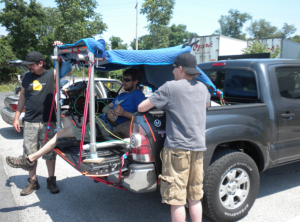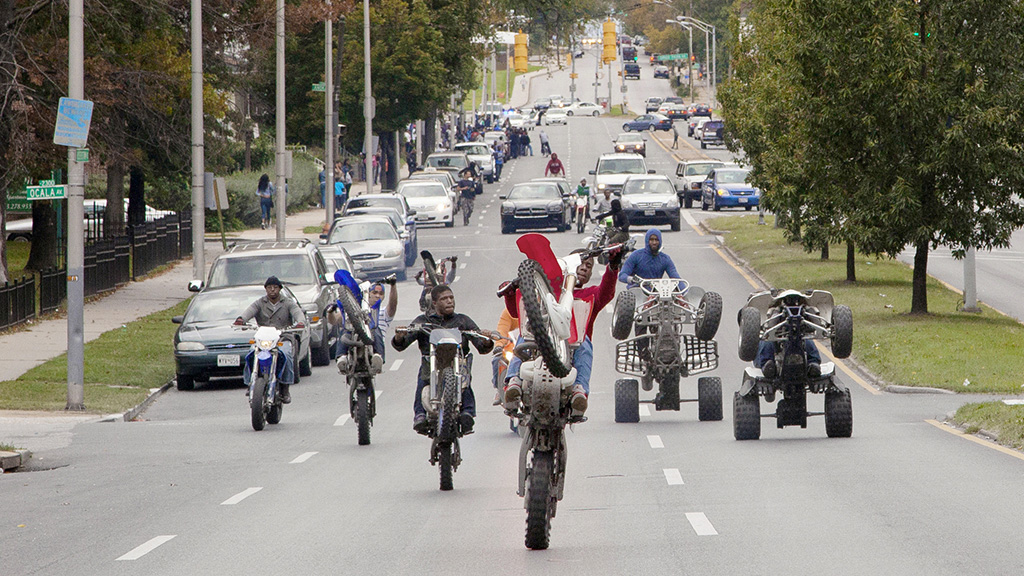12 O’Clock Boys’ Eric Blair takes Baltimore audience behind the scenes
(A screenshot from the movie 12 O’Clock Boys – courtesy Oscilloscope Laboratories)
It’s been called “The Wire with wheelies”, and for those who had a chance to see the gripping film 12 O’Clock Boys this week at the Charles Theatre, that description might well carry along with it a bag full of mixed emotions. How was this film shot? Who are these outlaw riders? Why doesn’t the city stop them? Why would anyone make a film which seems to glorify this lifestyle?
Eric Blair, the producer of the film, addressed some of those concerns yesterday morning during an hour-long behind-the-scenes talk at the Eubie Blake Center in Baltimore. Blair’s presentation was the latest installment of the new Creative Mornings Baltimore series.
12 O’Clock Boys is a documentary which looks at the outlaw street dirt-bike culture which permeates some of the poorer neighborhoods of Baltimore City. The film is currently the second most popular documentary in the world. It is also the tenth highest rated independent film.
The film is unique as well in that it is a hit simultaneously in both theaters and video on demand.
A motorcycle rider himself, Blair became intrigued with the idea of doing a feature length documentary on this seething sub-culture after seeing a short student film on the subject by Lotfy Nathan. Nathan was enrolled at the Maryland Institute College of Art (MICA) when he began filming the ubiquitous street bikers in action.

While the film features shots of more than a hundred riders, the story revolves around a precocious boy named Pug; his mother Coco; and Steven – a man in his thirties who is seen as a sort of patriarch to the urban riders.
Blair told the audience, “It was a four-year journey to make this happen. Coco and Pug were pretty courageous in allowing us to show their lives on screen.” (During the course of filming, Coco’s 18 year old son died from an asthma attack.)
Pug was only 11 when he became the center of the story. “Lotfy was shooting a lot of footage around town, and Pug just sort of rose up from the crowd; trying to do wheelies on his bicycle,” Blair said.
The bicycle wheelies, of course, are nothing compared to the heart-stopping images of the dirt-bike riders doing wheelies straight up – or at 12 O’Clock.
The more ephemeral shots – presented in slow-motion – were filmed from the back of a pick-up truck. In many cases, Steven drove the truck, since he was adept at piloting a vehicle in the middle of the pack of riders.
“We used a Canon 7-G along with a Phantom to capture the riders. If you see the movie in a theater, you’d never believe so much of it was shot with a $780 dollar Canon camera off the shelf. The high speed Phantom camera can grab 1000-4000 frames per second (fps). We see life at 25-30 fps, so we slowed our film down to 500-600 fps.”
“The Phantom scenes were highly composed and choreographed. It was a tightly controlled process to be safe, especially for Pug. Pug was very involved in the process, as both a rider and as an actor. I learned that showing Pug and the other riders the footage was very helpful in explaining the process to get them to go along and hit their marks.”

For safety, Blair also made sure his crew was securely strapped into the back of the truck. “We did everything we could to do this professionally, including taking out a 2 million dollar insurance policy.”
Even so, the city turned a wary eye to the film maker’s effort. Director Lotfy was even arrested once but was ultimately released, when Blair’s attorney pointed out that there is nothing illegal about filming an illegal activity.
“I don’t like to get into the politics of what many people see as nuisance riders. The city wants to stop this activity because it is scary. I get emails from people telling me I shouldn’t glorify this behavior; that they know people who have been hurt or killed by the boys on bikes.”
“There’s a credo among bikers: Live free by riding. These guys are doing things in an outlaw fashion. We all have an outlaw spirit ~ this is America. But these guys aren’t bad. All they want to do is ride.”
The four-year project created a bond between the production team, the cast and the outlaw riders.
“When we finally got the signature shots for the film, a few tears were shed.”
Blair credited his sound design team (including the ethereal choir); the gripping footage captured by Lotfy; a wonderful editor and the Phantom camera for the success of 12 O’Clock Boys. There will be an extended release on Showtime with added footage (the film presently runs 71 minutes).

When asked about his next project, Blair laughed and assured the audience that, though it does have a Baltimore connection, it will have nothing to do with illegal activity.
As for Pug (who is now 16 and doing great in school), Blair said, “Whatever Pug does for a living – whatever he may be – he’ll carry what he learned on the streets; coming from this guerrilla lifestyle.”
“George Lucas was declared dead after a crash while drag racing. He realized he had to change and do something different, so he became a film maker. But much of his work on American Graffiti and Star Wars came from his experiences; from his perception of speed growing up.”
Blair concluded his remarks, saying, “I want people to come away with the feeling that they were there. But it’s like Boogie Nights. You don’t want to watch a film like that and then go out and do it yourself. It is not a sustainable lifestyle. I just hope people take that away from this film.”

Anthony C. Hayes is an actor, author, raconteur, rapscallion and bon vivant. A one-time newsboy for the Evening Sun and professional presence at the Washington Herald, Tony’s poetry, photography, humor, and prose have also been featured in Smile, Hon, You’re in Baltimore!, Destination Maryland, Magic Octopus Magazine, Los Angeles Post-Examiner, Voice of Baltimore, SmartCEO, Alvarez Fiction, and Tales of Blood and Roses. If you notice that his work has been purloined, please let him know. As the Good Book says, “Thou shalt not steal.”

